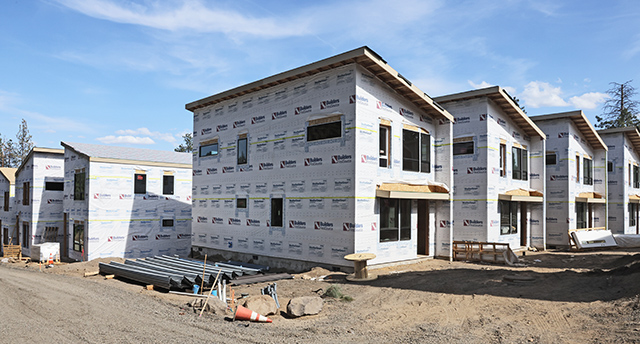Central Oregon lacks bed capacity for children in mental health crisis
Published 5:30 am Tuesday, February 6, 2024

- Central Oregon children who are either a danger to themselves or others, experiencing a mental health crisis, and need to be hospitalized can only get treatment across the mountain in just one of 165 beds. Sometimes they wait for weeks.
Central Oregon children who are either a danger to themselves or others, experiencing a mental health crisis, and need to be hospitalized can only get treatment across the mountain in just one of 165 beds.
Sometimes they wait for weeks. Other times it’s just days. But the families of the children in crisis have only 24 hours to make the journey.
It’s been this way for years.
Oregon ranks 45th in terms of the incidence of mental illness in youth and 49th for adults, according to a 2022 report from Mental Health America, a national nonprofit established to promote mental health and illness prevention. The organization estimated that at least one in 10 youth in the United States experience depression that severely impairs their ability to function in school and at home.
And most, about 60% of the youth, do not receive mental health treatment in the United States, according to the health ranking report.
The pandemic put a full stop on any progress in Central Oregon toward finding a place for in-patient treatment for children and youth, define as anyone under 18.
“It’s frustrating,” said Holly Harris, Deschutes County Health Services behavioral health director. “We are a growing county and region and it’s time. We have a lot of people working on this.”
In Oregon, there are 44 hospital beds for youth, but facilities are only able to accept 41 youth because of workforce shortages, said Tim Heider, Oregon Health Authority Behavioral Health Services strategic communications officer. Across Oregon, there are 200 beds for psychiatric residential treatment, but workforce shortages allow for only 165 youth, Heider said.
The process
When a child comes into a hospital emergency department, either with the parent or with law enforcement, hospital staff evaluate safety concerns for the child or the community. Staff look to see if the child has the means, or a plan to cause danger or if the child is out of control and may cause danger to others, said Harris.
The goal is always to look for the least restrictive care alternatives, Harris said. It’s always better for the child to remain at home or in the community, rather than in a facility, she said. And it’s not beneficial to keep a child in an emergency room bed for days while waiting for a facility to have an opening, she said.
It can be damaging, said Dr. Mike Conner, a Bend psychologist.
“They’re sitting with their feelings and not talking to anyone and not getting the help they need,” he said.
A medical and psychiatric evaluation is done in the emergency department, said Michelle Brenholdt, St. Charles Health System director of emergency services for Bend and Redmond. The medical staff talk with the child and to the parents to obtain information about the symptoms the child has, she said.
“That can take a while,” Brenholdt said. “We come up with a treatment plan. If the patient is safe to go home and needs to be connected to services, that is set up before leaving. The psychiatric team does a safety plan.”
But sometimes the mental health symptoms are acute, Brenholdt said. If the child or youth express suicidal ideations or appears to be unsafe, the child or youth is then referred to a higher level of care at an in-patient facility. The wait list is usually long, she said. It be two days or as much as 14 days, and if the child or youth has developmental disabilities, it could take even longer.
“If that happens, we continually observe the patient and reassess several times a day,” Brenholdt said. “Most often we can safely discharge youth home with their parents to get continued outpatient support.”
The psychiatric team at St. Charles works to help the child and the family to manage feelings. Sometimes food and sleep can encourage the patient to be more open to therapy, especially if the child has been in crisis and has not been eating or sleeping.
What is available
It did look at one time, that Central Oregon was a step closer to funding a residential pediatric mental health treatment center. That was in 2019. The work group in charge of finding, building and establishing a mental health in-patient pediatric psychiatric unit had identified a space, obtained several grants and was on a course to get something built.
But then the price tag of $34 million put the kibosh on any plans, Harris said.
“We were very disappointed,” Harris said. “Now we’re back talking about the issue again. What we have learned is if we have to pay for the building, it won’t happen. It’s just too big a price tag.”
The 5,300-square-foot Deschutes County Stabilization Center, which opened in 2020, helps those experiencing emotional crisis to get refocused and have access to care. But the center is small and doesn’t have room for children. Its focus is adults.
Since it opened, it has had nine people come a day, according to the Stabilization Statistical Impacts Report by Deschutes County. About 14% of the people say they would have gone to the emergency department at a hospital instead of the stabilization center, but a third of them said they weren’t sure where to go in a crisis.
The center launched a Community Crisis Response Team last year that provides 24/7 mental health crisis intervention services in the community. Since it opened in May, 74% of the 1,821 calls for intervention were resolved by phone and 26% of the interactions required face-to-face contact, according to the report.
“The stabilization center is different than a residential in-patient center,” Harris said. “The stabilization center has a max of 23 hours of time anyone can stay. The center here has a small footprint. We can’t co-mingle adults and children together.”
Gov. Tina Kotek gave $25 million to coordinated care organization to expand youth behavioral health capacity.
The funds went to:
- $13.2 million Trillium Family Services project in Portland metro area to spur new psychiatric residential treatment bed capacity.
- $7.5 million to Adapt Project, a program based in Douglas County. The funds will support an in-patient treatment campus underway in the region.
- $2.3 million to the Looking Glass project in Lane County to expand a psychiatric residential treatment capacity.
- $2 million to Community Counseling Solutions Project in Morrow County to close a funding gap for new psychiatric residential treatment beds.
One family’s story
While there are beds and services like the Stabilization Center accessible for adults in Central Oregon, sometimes even adults have difficulty navigating the system.
There were many times when Redmond resident Julie Leutschaft took her son to the emergency department in hopes of getting help. At the time, he was in his early 20s. Often after hours of waiting, she’d leave with a list of potential therapists that she’d have to cull through to see who was taking new patients and then they’d have to wait several weeks for help.
In the end, nothing helped. Her son committed suicide in 2021. He had been diagnosed with depression and anxiety, Leuschaft said.
“It was very difficult to navigate,” said Leuschaft, who with her husband has created an annual fundraising event at Wildride Brewing to support other families. “He was an adult and we couldn’t treat him like a young person. We were naive about mental illness.
“We didn’t understand the severity of his illness.”
Each time there was a crisis, the Leutschafts encountered challenges. Their son would find and get comfortable with a therapist, only to have the therapist move or their health insurance would change the coverage. With each new doctor, the medication would change or her son would forget to take it. Sometimes the diagnosis would even change.
“It’s hard to start over with a therapist,” she said. “It’s hard to tell your story over and over again. He didn’t have the words to explain what was going on in his head.”
Deschutes County 24-Hour Crisis Line: Crisis services is a 24-hour program that responds by phone or face-to-face.
541-322-7500 ext. #9
988 Suicide & Crisis Lifeline: The Lifeline provides 24/7, free and confidential support for people in distress, prevention and crisis resources for you or your loved ones, and best practices for professionals in the United States.
Call 9-8-8
Text 9-8-8
Visit 988lifeline.org to message.
National Suicide Prevention Lifeline: a national network of local crisis centers that provides free and confidential emotional support to people in suicidal crisis or emotional distress 24 hours a day, 7 days a week in the United States.
1-800-273-TALK (8255); TEXT “273Talk” to 839863
For Veterans press #1
Ayuda en español llame (for Spanish language call) 1-888-628-9454, TEXT “MIL1” to 839863
For Hearing and speech impaired call 1-800-799-4TTY (4889)
Oregon YouthLine: YouthLine is a free, confidential teen-to-teen crisis and help line
877-968-8491 or text “teen2teen” to 83983
Leuschaft said she advocated as best as she could, given her son was an adult. Given the protections under the Health Insurance Portability and Accountability Act, it was always a challenge, she said. Since her son’s death, she and her husband have been vocal in their advocating for the treatment of mental health issues.
“Depression, if left untreated, is a recipe for disaster,” Leuschaft said. “When you notice the symptoms, especially in younger people, while the brain is still developing, you have to deal with it. It’s not going to get better on its own.”
The Suicide Grief Support Group holds a monthly meeting on the first Tuesday at St. Charles Redmond from 6:30 to 8 p.m. For information, contact leutschaftj@gmail.com
Moving forward
There are several groups trying to solve the problem. One is the Central Oregon Health Council Regional Health Improvement Plan trying, which is collaborating with other agencies and mental health officials to create a place for those experiencing a mental health crisis, said Lee Dawson, PacificSource spokeswoman.
Limited access for pediatric patients for residential treatment is an issue concerning not just Central Oregon, but is across the state, as well, said Dannielle Brown, PacificSource coordinated care organization behavioral health director.
“In Oregon there’s a huge need for inpatient care for children and youth,” Brown said. “At most only about 40% of the children who need in-patient services are getting help. It’s challenging.
“We’re working on it.”
Insurers like PacificSource are funding workforce development grants to increase the number of mental health professionals entering the field, Brown said. They’re actively working with community mental health programs to find physical space for pediatric care or to expand for adult mental health care, Brown said.
“In a picture perfect world, resources would be easily accessible for children and families to access before a crisis develops,” said St. Charles’s Brenholdt. “The emergency department is not the best environment. It’s busy and chaotic. We do our best to create a healing environment. We want families and children to see this as a safe place.”







